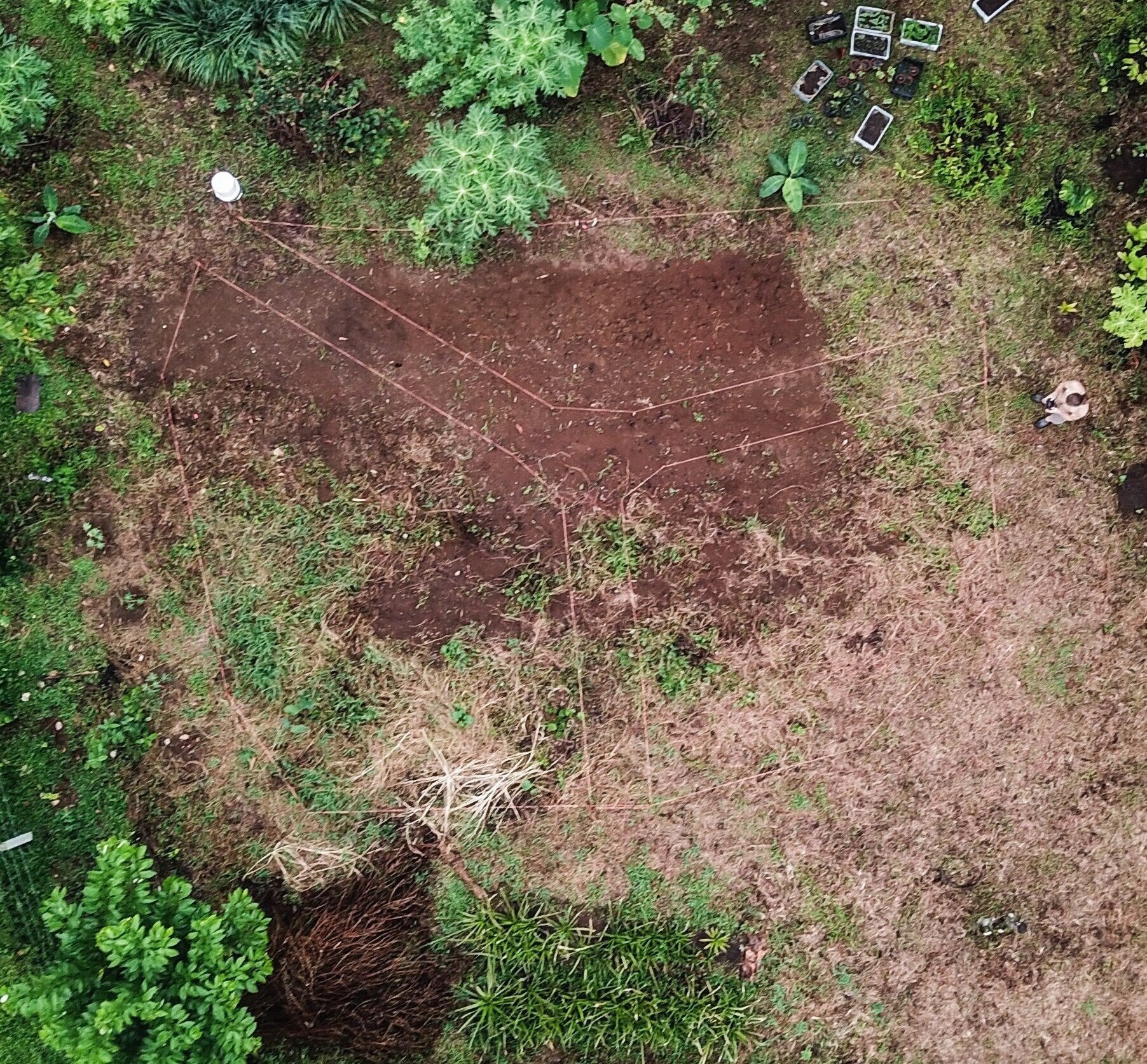“One must begin in one’s own life the private solutions that can only in turn become public solutions.” Wendell Berry
It is with this in mind that I personally explore the problem of economics. I have a university degree in economics, but my studies did not touch upon the etymology of that word—derived from the Greek oikonomia meaning “management of the household.” My studies set me to master Microsoft Excel, to calculate complex regression analysis, and prepared me for a job in finance. They did not, though, prepare me for what to do with so many bananas.
And that is where I find myself today, on a Sunday, decanting banana vinegar, dehydrating bananas, eating patacones for breakfast, and freezing bananas. Writing to neighbors to come and take some bananas because the next four bunches are upon me. This is the not so trivial management of the household, or in economic terms how to distribute abundant or scarce resources. Homestead strategies which turn private solutions into public ones.
I am writing from a small piece of land. It is my trial homestead. It is a house and parcel that we, our Porvenir Design team, receive as part of a work contract with a number of neighboring properties. This blog and video document the design, installation, and lessons of this small homestead in rural Costa Rica through the lens of permaculture design. Our work as professional permaculture designers often means we are working on larger properties and that we aren’t involved with the details of daily life on a piece of land; rather we support clients and work crews in those efforts. This project is unique in that our team spends significant time on site, as this is my current place of residence and someone else from our team, Hugo Soto or Sam Kenworthy, visits for an average of a week per month. It has become an opportunity for us to trial smaller scale systems and begin to understand the potential of intensively focused production.
You can see a complete photo album here.
Special thanks to Elena Valverde, Iva Alvarado, Sol Sphinx for their photos and Travis Wals for the video creation.
Context
This house and land is located in San Isidro de Peñas Blancas, Alajuela, Costa Rica. I have written two previous case studies on neighboring properties that discuss the context of the location more. You can find those here and here. I won’t repeat the details of climate, watershed, rainfall, etc in this post.
The house was constructed over 30 years ago and served as a simple homestead for around two decades. Upon our arrival the home and land had been abandoned for around 10 years; it was an uninhabitable space with no roof. The land around the parcel was a lightly used pasture that the neighbor would put his cows on when he had no more forage during the driest times of the year. The pasture was on the verge of abandonment as well.
I moved to this area in December of 2018 and onto the land in February of 2019. We were given explicit permission from the owners to transform the property. They subsidized the initial investments of labor and amendments to start the project in exchange for this documentation.
The below site analysis was completed in early 2019 as our team began studying the property and making a plan for its development. The parcel measures 800 square meters in total. The planting was begun in April and May of 2019. The photo documentation occurred over the following two years. The before video was recorded during April 2019 and the second video in July 2021.
Purpose
The purpose of the homestead is as follows:
Demonstrate what is possible on a small piece of land with minimal inputs.
Create an intimate trial homestead for myself.
Be a repository for seeds and hard to find plants that require detailed attention.
Create a beautiful, private and comfortable living space for myself and friends.
Create a comfortable and productive work environment for our design business when we are working in the region.
Design
The original concept plan can be seen below. The practical goals of this design were the following:
Create privacy from the road with a plant barrier.
Manage all rain and storm water through the installation of gutters, rainwater barrels, a small tilapia pond, sediment basins, and drainage swales to slowly control the flow of water.
Retrofit the existing greywater systems to fully leverage this resource.
Produce all the homes’ needs in salad greens, cooked greens, starchy tubers, and culinary herbs.
Grow a small collection of fruit trees, shrubs, and edible palms which fit with my culinary preferences and for which I have the ability and tools to process.
Use waste building materials from nearby client projects for all retrofits and infrastructure needs (garden trellis, path materials, rainwater barrels, etc).
From these practical aims it has become a place for experimentation, for bird watching, for showing guests the potential of plants properly placed and so much more.
Species
The linked species list came about from a quick peak around the property. This list is missing about 20 to 30 ornamental plants and ground covers. There are a total of 126 unique species, in the species list, that have been deliberately planted. In summary there are 150 species of useful plants in this 800 square meter space. If you look at the primary use category, you will see that it is dominated by Fresh Fruit, Medicinal, Ornamental, and Salad Green. Medicinal in this case includes culinary herbs, spices and plants more traditionally considered medicinal.
Installation
Nearly all of the installation work occurred in the first six months on site; from April 2019 to October 2019. The bulk of this work was done with occasional hired workers, with help from our Permaculture Design Course students, and some heavy work by Sam, myself, and a number of friends. I estimate that in total this was 15 days of work. The primary work included:
Pruning edge trees
Collecting, organizing and distributing biomass
Laying out and digging garden beds
Cleaning up site garbage
Planting trees
Applying amendments
Sourcing plants from nearby Finca Luna Nueva
Digging and lining the small tilapia pond
Installing gutters, rainwater barrels, greywater systems, and small earthworks

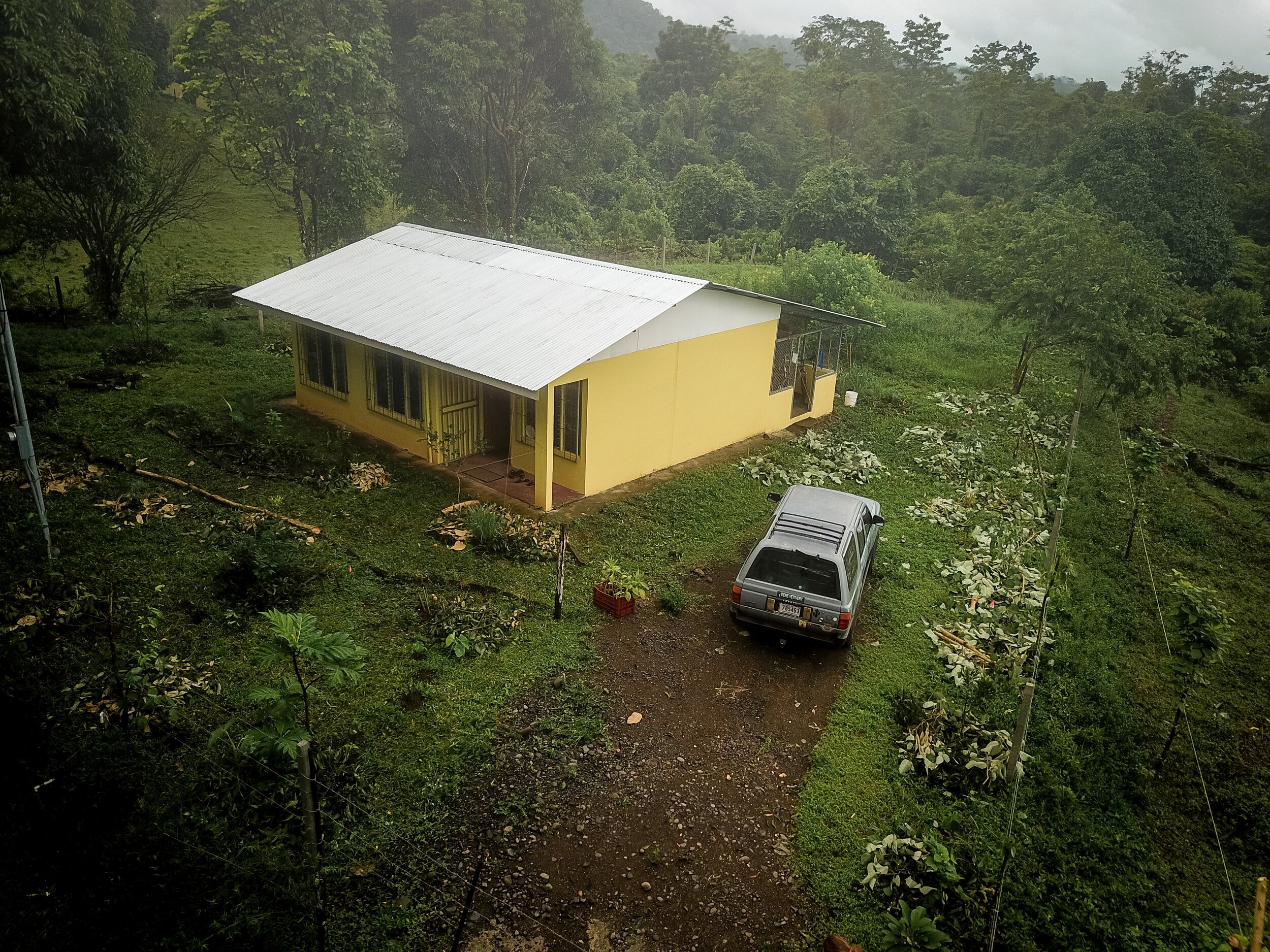
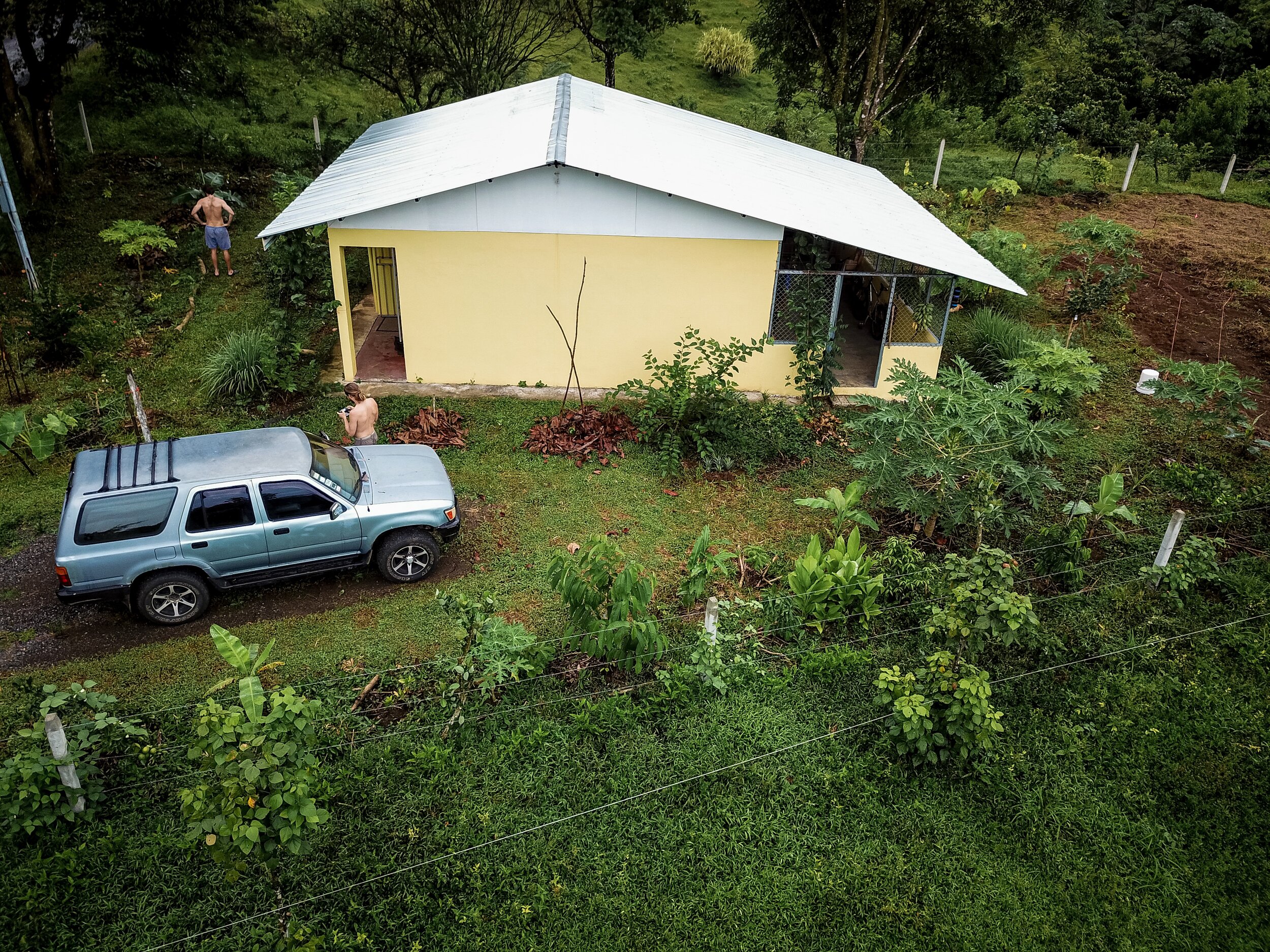
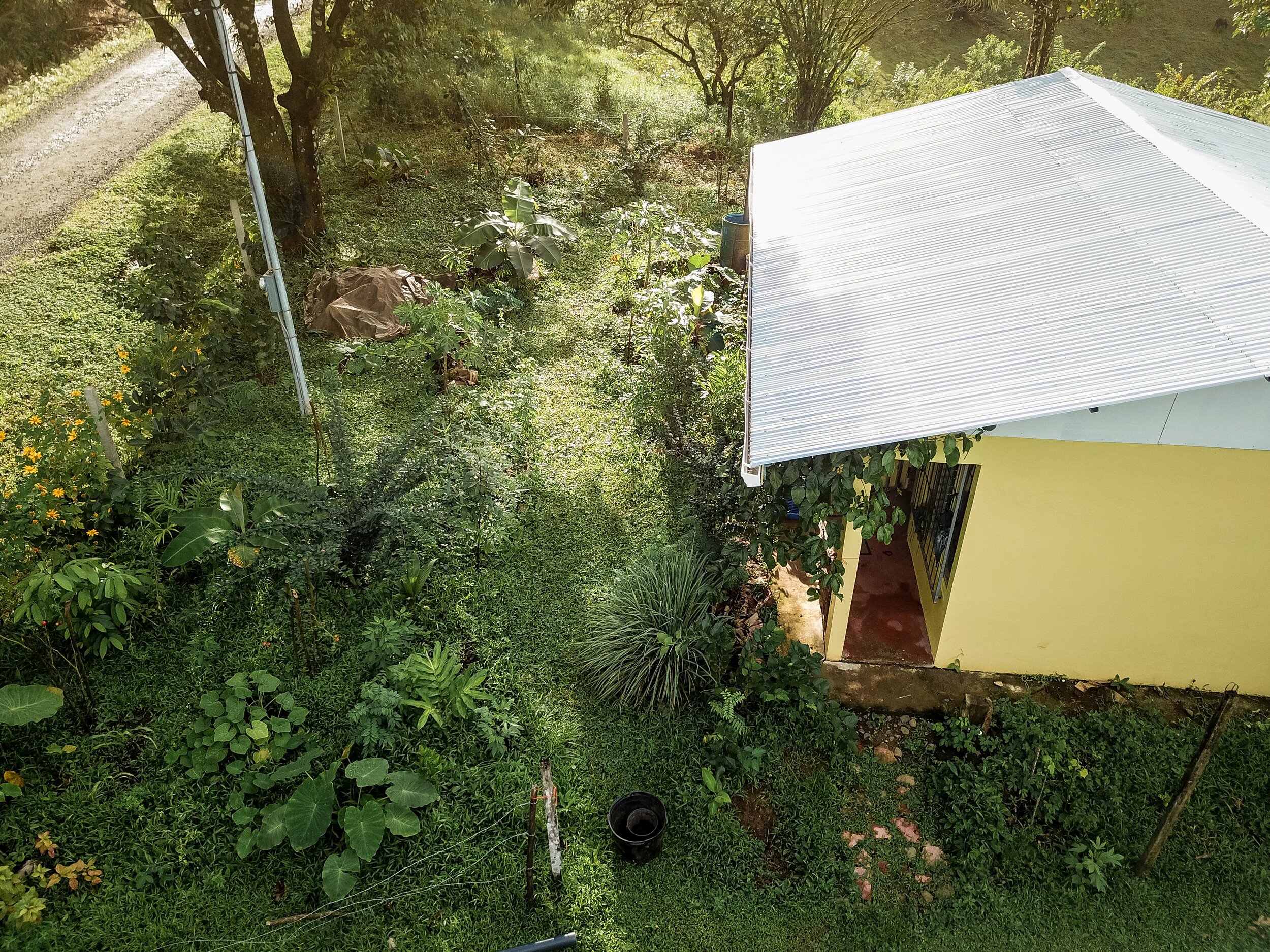
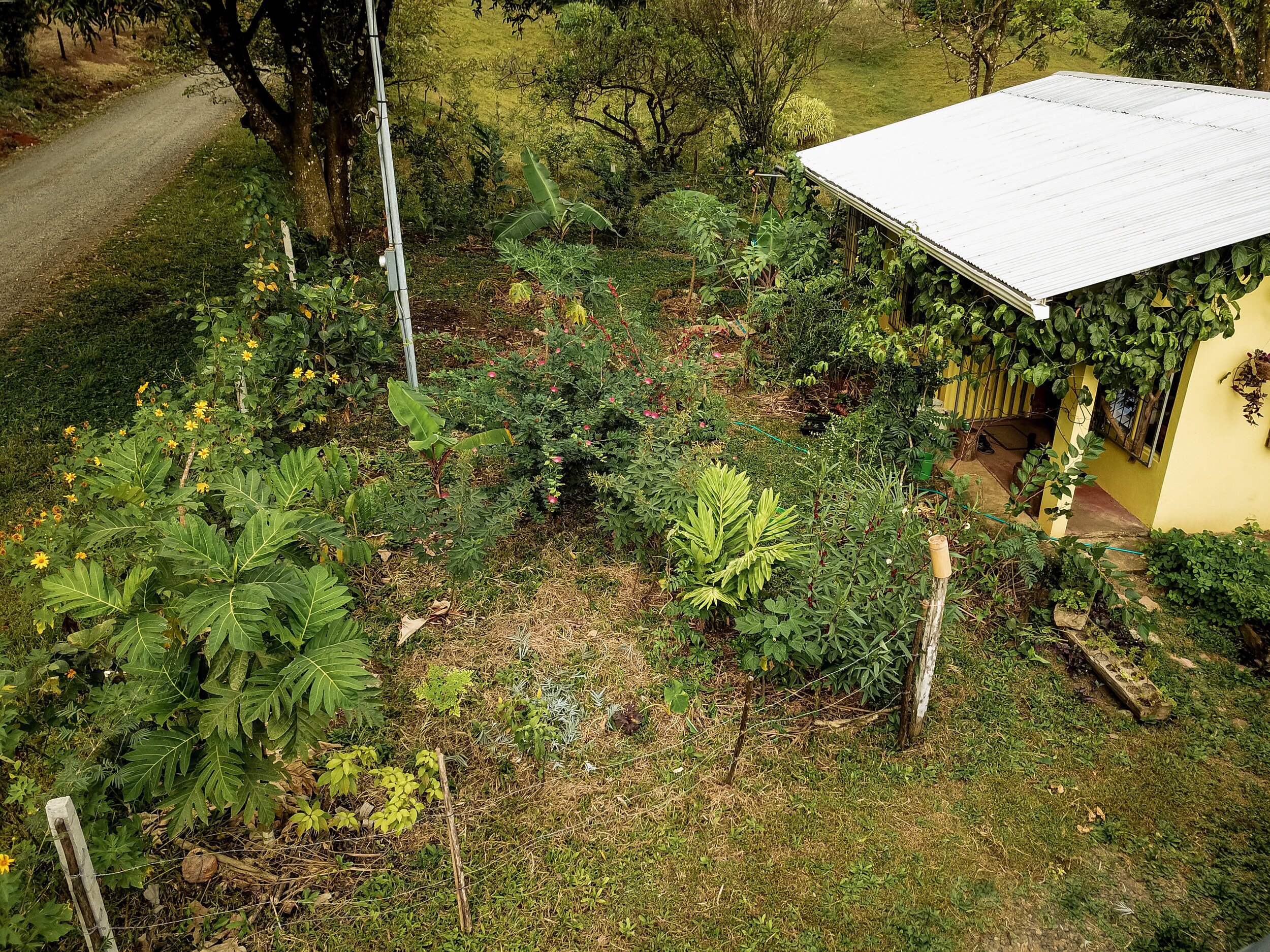

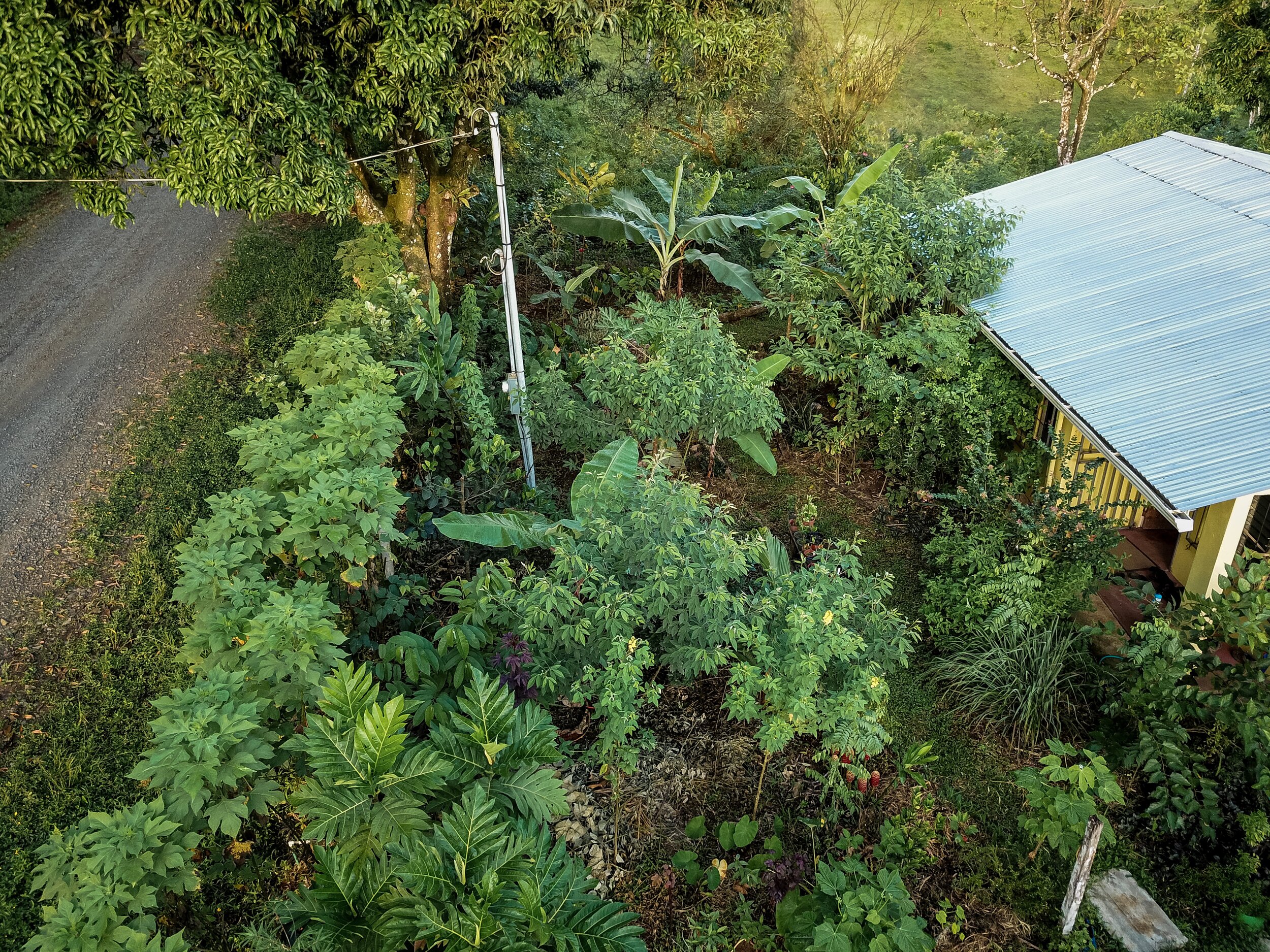
Outside Inputs
A review of outside inputs applied over the entire two years of the system, aside from labor, looks as follows:
30 sacks of compost
20 kg of rock phosphate
20 liters of mountain microorganism
1 liter of fish emulsion
5 liters of EM 5 (homemade insecticide)
10 sacks of wood chips
6 sacks of biochar
Various pipes and fittings for the rainwater and greywater systems
Materials for the construction of the yoga deck
Fruit trees: Most of these were brought from my previous nursery at Rancho Mastatal. Many of these were already two to three years old upon planting.
Additional plants: Many were sourced for free from our clients and projects around the country, in particular neighboring Finca Luna Nueva.
Maintenance
Over the two plus years managing the space, I’ve found that the maintenance goes in cycles. It depends on my motivation, the weather, helping hands, new seeds, etc. Below are the principle maintenance activities and how often they occur.
Weed trimming: one day, every other month
Garden weeding: weekly for 30 to 60 minutes
Pruning and mulching: one day every other month
Applying the pee bucket: every morning
Applying pest control or fertility foliar feeds: every other morning
Reseed/planting the garden beds: a half day, every other month
I estimate that this work takes two days per month to complete. Most of it is very light work. The weed trimming only takes two hours. The most strenuous is weeding the garden beds. This could nearly be eliminated with more grown or purchased mulch (wood chips or straw bales).
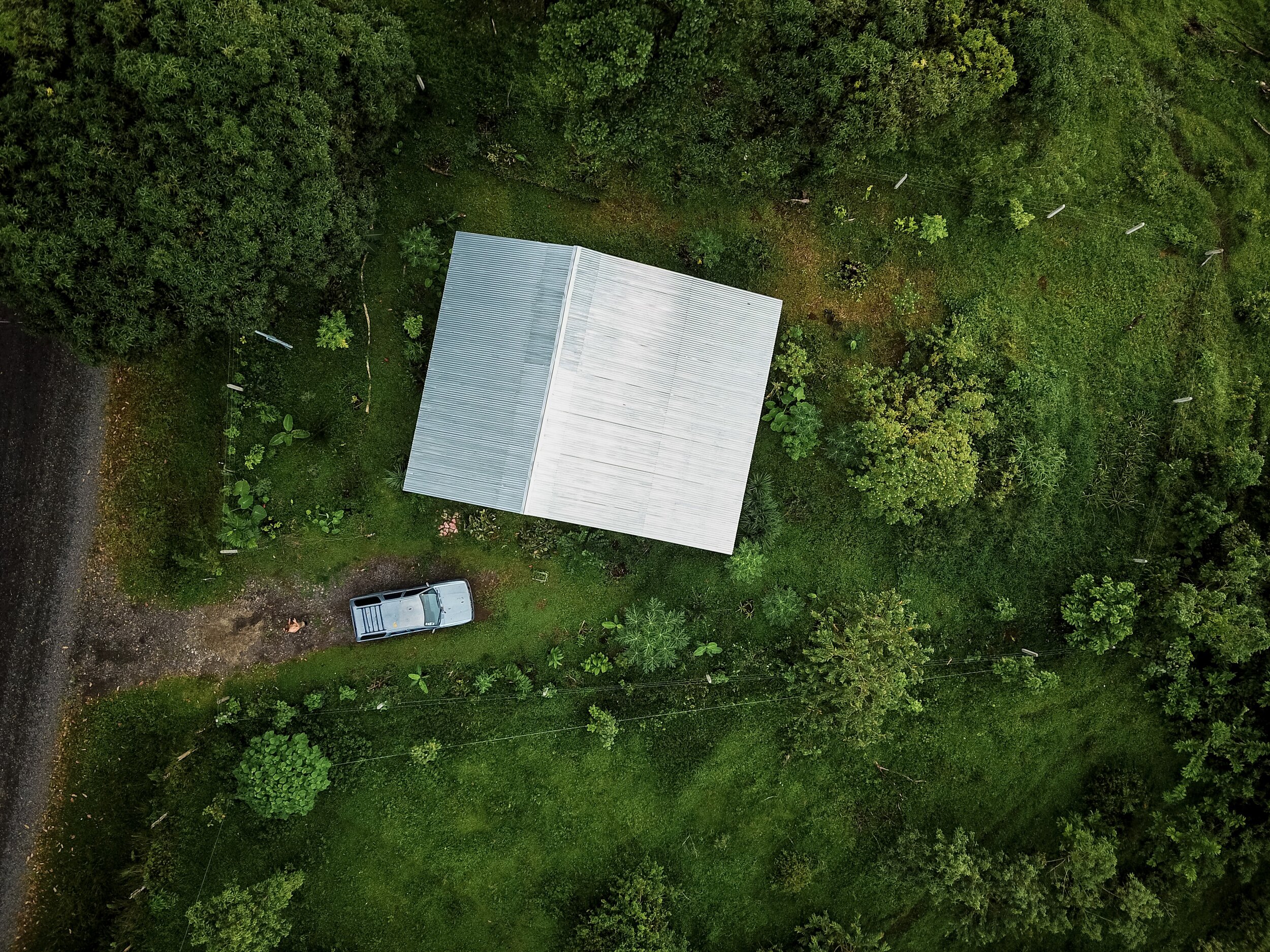

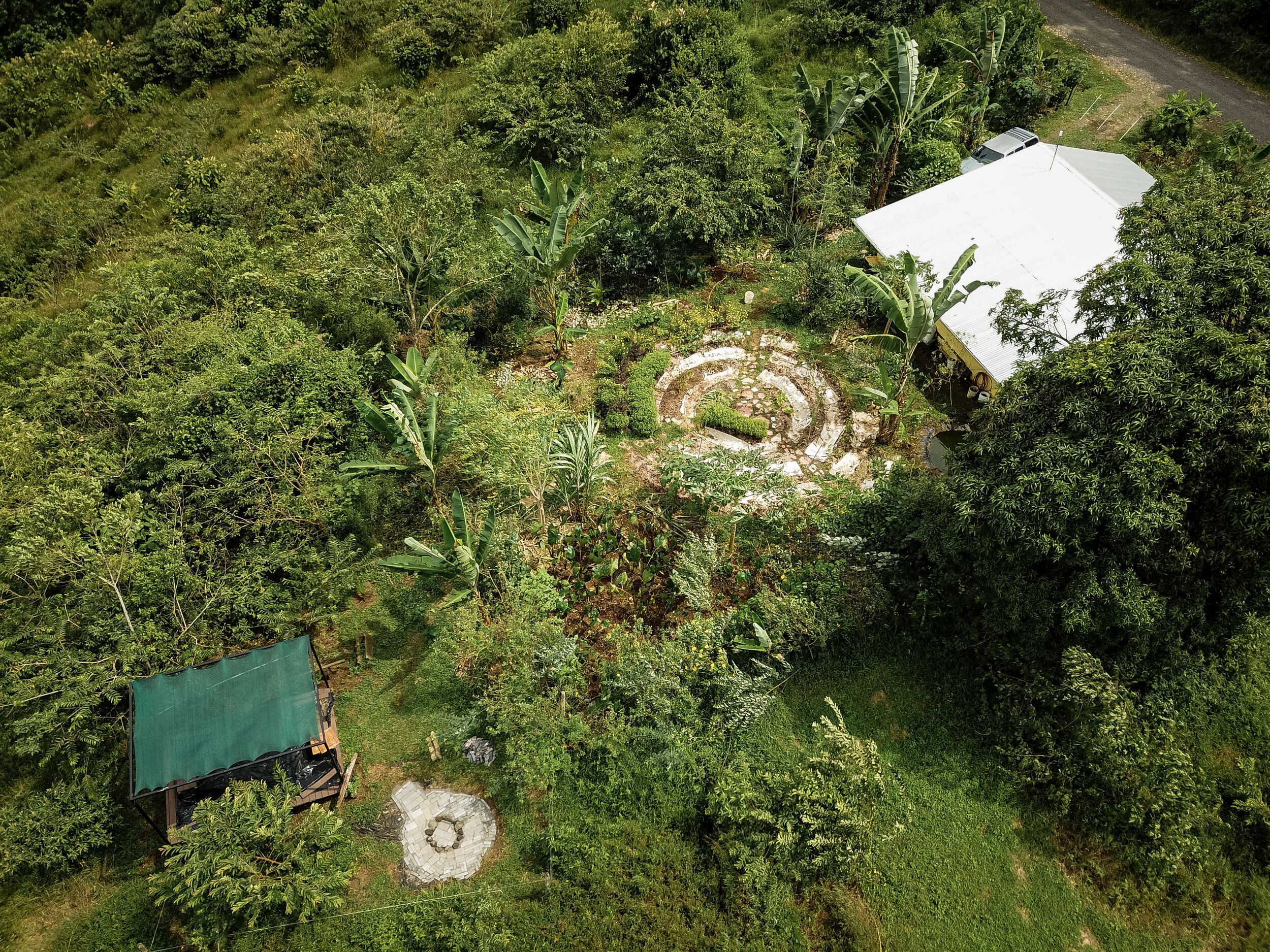

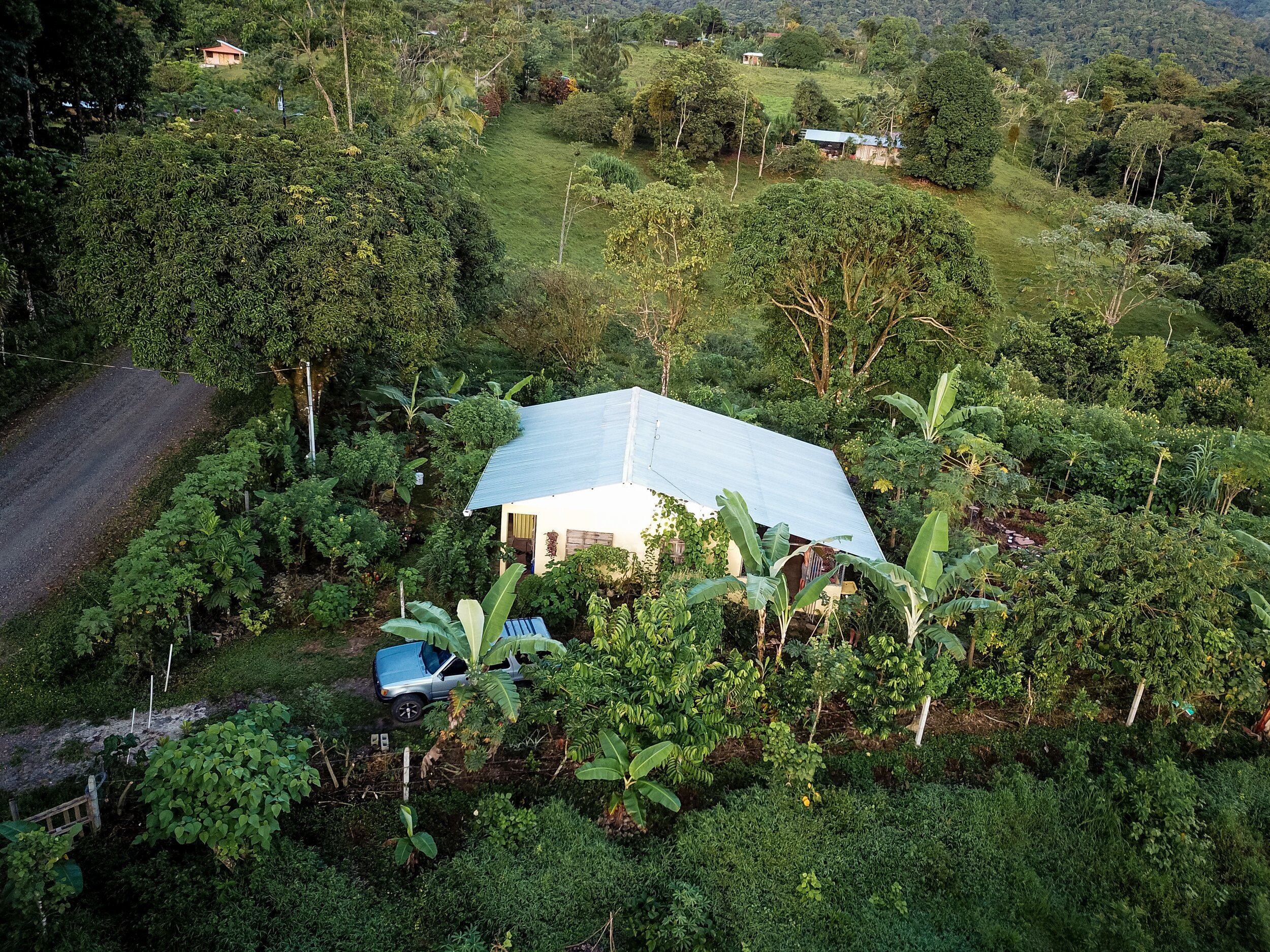


Feedback
Working on this small lot has provided significant insight into what is possible on this scale. The following are some of the key takeaways after two and half years on site.
Small is Beautiful: This property has convinced me that I need a much smaller piece of land for myself in this world. The ability to grow food intensively, minimize overhead costs (and hence the need to work for wages), while concentrating nutrients, work, and observation in one place is all vastly amplified by having physical constraints of less square meters under your steward.
Good Neighbors: Being located in an agriculture community has huge benefits. Finding good help, plants and seeds, and advice is easy here. As well, the parcel is next to Finca Luna Nueva, one of our principle clients. With this relationship we have access to plants from one of the countries longest running organic farms and a near botanical garden of important species.
Pond Challenges: Our little pond only receives water from rain, and in emergencies from the house’s potable water. This means that despite the pump aeration, the water quality is not high enough for a large amount of tilapia fish. Out of the 50 we stocked the pond with, only three are still alive.
Self Seeding Plants: Cranberry hibiscus, indian lettuce, quail grass, basil, tomato, okra, marigold, etc. are now coming up on their own in the garden. All I have to do is gently transplant them where I want them. These plants are very content in the garden, growing without any effort on my part. They will become larger and larger parts of my diet because of that.
Pest Control: This is my first time in over a decade involved with the daily growing of annual vegetables and more pest sensitive plants. I learned that the first planting of something, squash for example, is often very productive; but the second cropping usually brings in the pests and it is harder to obtain a yield. But as soon as I became diligent on spraying with homemade pest controls, many of these crops became very productive again. This requires my daily presence if I want to eat nightshades and Cucurbitaceous species for example.
Sun and Shade Balance: Every few months I notice new plants that are ready to be heavily pruned or removed from the system. First the papayas were shading the garden and not producing well so they were removed. Aggressive pruning on the guayaba tree and the mango tree was carried out. Soon, one poorly sited banana will be removed as well. The creep of the shade and the drip line of overstory and emergent plants severely affects these smaller, intensive spaces.
Keep Greywater Simple: Our first attempt at a greywater system was an artificial wetlands using an old Rubbermaid tote, buckets, 2 in. pvc, etc. We found that this system clogged up easily, attracted a lot of ants, and was not particularly attractive. After 18 months trying to make it better, we switched to the classic banana circle and it is growing some very beautiful plantains right now.
Conclusion
At some point our impact on the world must become specific and tangible. We can write and design, we can protest, run for office, disinvest, fundraise, educate, and so forth; but at the end of the day it is the choices that we make at the household level, the choices that we can control most, which we have the most power over. This is economics.
I do not own this piece of land. I likely won’t own it in the future, but upon our team’s arrival here I made the deliberate decision to turn it from a house into a home. It was an eyesore in the community, now people slow down as they pass by to see what is growing. My postal code is “the yellow house covered in plants.” We can not only regain so much power on such a small piece of land, but find joy, stillness, and meet nearly all of our needs.




